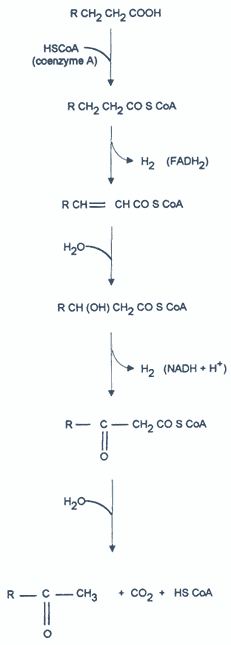 Molecules that contain the carbonyl group (=C=O) are called ketones and are responsible for many natural flavors and odors. Methyl ketones exist in their precursor form in fresh butter as alkanoic acids. As such, they may be only marginally important in contributing to the flavor of fresh butter. However, when heated, the precursors are converted to methyl ketones and their total concentration rises above their FTV. Thus they are very important in providing flavors associated with heated or cooked foods containing butter. Methyl ketones are important flavor components, especially of blue cheeses; Penicillium roqueforti for instance produces 2-pentanone, 2-heptanone and 2-nonanone (pathwayt shown on right).
Molecules that contain the carbonyl group (=C=O) are called ketones and are responsible for many natural flavors and odors. Methyl ketones exist in their precursor form in fresh butter as alkanoic acids. As such, they may be only marginally important in contributing to the flavor of fresh butter. However, when heated, the precursors are converted to methyl ketones and their total concentration rises above their FTV. Thus they are very important in providing flavors associated with heated or cooked foods containing butter. Methyl ketones are important flavor components, especially of blue cheeses; Penicillium roqueforti for instance produces 2-pentanone, 2-heptanone and 2-nonanone (pathwayt shown on right).
Diacetyl (2,3-Butanedione) shown at left, is another ketone flavorant and is very important in providing the rich or heated note in butter flavor. Diacetyl is also the primary flavor compound in starter cultures and distillates which are used in producing cultured butter. It is a volatile yellow liquid ketone with a cheese-like smell. It is, in fact, the molecule that gives butter its characteristic flavor and the molecule you should have in mind when you smell it; for when cream is incubated with bacteria, they produce some butanedione. After incubation, the cream is churned. This breaks down the sheaths around the fat droplets, and they coalesce into a soft, solid mass. Sheep's milk and goat's milk are richer in short-chain trigylcerides than cow's milk, and cheese made from them (such as Roquefort) is richer in pungent molecules.
Diacetyl is also the primary flavor compound in starter cultures and distillates which are used in producing cultured butter. It is a volatile yellow liquid ketone with a cheese-like smell. It is, in fact, the molecule that gives butter its characteristic flavor and the molecule you should have in mind when you smell it; for when cream is incubated with bacteria, they produce some butanedione. After incubation, the cream is churned. This breaks down the sheaths around the fat droplets, and they coalesce into a soft, solid mass. Sheep's milk and goat's milk are richer in short-chain trigylcerides than cow's milk, and cheese made from them (such as Roquefort) is richer in pungent molecules.
Diacetyl and acetoin produced by lactic streptococci are flavors characteristic of butter, buttermilk and sour cream. Diacetyl also imparts a yellow colour to dairy products; it is formed from citrate via oxaloacetate and pyruvate which is de-toxified to form diacetyl and acetoin. An essential step is transport of citrate into the cell by an inducible citrate permease. Natural diacetyl can also be obtained from starter distillate, a by-product from the manufacture of dairy starter cultures.
You may be able to smell butanedione by sniffing your armpits or someone's unwashed feet, because it is a contributor to the odor of fermenting perspiration. Fresh sweat is almost odorless, but th action of the bacterium Streptococcus albus, which is present on the skin, increases its aciditiy and makes an inviting feast for other bacteria; they, in turn, excrete pungnet compounds including butanendione.
Cultured butter
Cultured butter, common in Europe, differs in flavor from sweet cream butter. Cultured butter has a more pronounced, distinct flavor that stems from starter cultures that are added to the cream during churning. As a result, flavor compounds from cultured butter are superimposed on those of sweet cream butter, creating a full-flavor effect. Starter cultures are typically mixtures of flavor concentrates produced by one strain or mixed strains of bacterial cultures. Streptococcus diacetilactis produces diacetyl, the flavor most commonly associated with flavored butter and Streptococcus lactis is used to produce lactic acid, which contributes to the acidic flavor typically associated with cultured butter.
» Read more about culturing butter.
